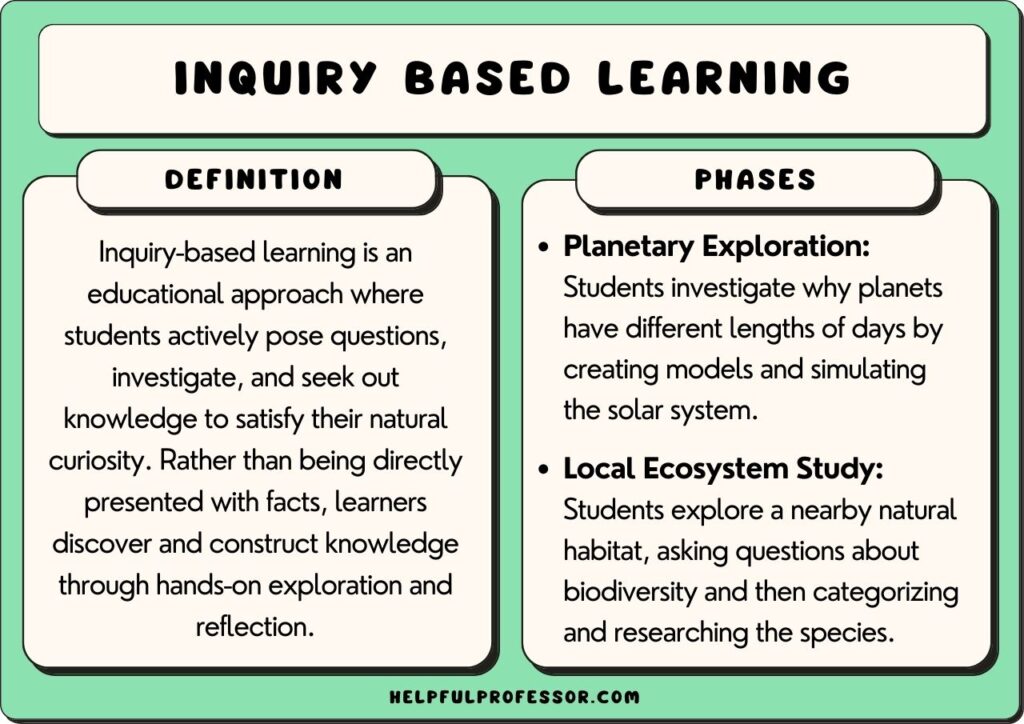

Written by Chris Drew (PhD)

Dr. Chris Drew is the founder of the Helpful Professor. He holds a PhD in education and has published over 20 articles in scholarly journals. He is the former editor of the Journal of Learning Development in Higher Education. [Image Descriptor: Photo of Chris]
| May 29, 2024
Inquiry-based learning is a learning and teaching strategy where students construct knowledge through a process of observation, investigation, and discovery.
Examples of inquiry-based learning include observational field trips, science experiments, and hypothesis-based research projects.
This learning strategy is believed to increase students’ level of engagement in the learning process. It is considered an active learning strategy that is in contrast to traditional approaches in education where teachers present information to passive learners.
Contents showIn inquiry-based classrooms, students engage in activities that provoke their curiosity as they go on a journey of discovery. Through the process, they construct knowledge rather than having it delivered by the teacher.
The students learn by exploring a subject, experimenting with concepts or objects, and conducting searches for information on their own.
Some scholarly definitions include:
Although John Dewey is often mentioned as a forerunner of inquiry-based learning, its roots can actually be traced as far back as Socrates (470-399 BC), the Greek philosophy that taught his students using the Socratic Method, which involved him asking his students questions repeatedly instead of imparting his wisdom onto them.
Pedaste et al. (2015) propose five phases of inquiry that can underpin the design of an inquiry-based project:
The benefits of inquiry-based learning are numerous:
The hallmark of any good inquiry-based lesson starts with an opening question. The teacher might not even announce the topic for that day’s lesson.
This is a simple but highly effective way to get the attention of the students right off the bat. When someone is asked a question, they can’t help but to start trying to answer it. That’s just the way the human mind is built.
Since getting the attention of a class full of 1 st graders can be a challenge in and of itself, teachers need to make use of every tool in the box. Hence, the game “what’s in the box?”
If the lesson is about animal habitats, then the teacher can place different items that are in that habitat in a box. As the kids begin to guess what’s in the box, the teacher can pull out one item at a time.
Once a few items are on the table, then the kids can start to guess the name of the habitat and the animals that live in it. It’s a lot of fun for the kids and is a great way to exercise their cognitive processes.
We often underestimate the ability of very young learners. They are actually a lot smarter than most people give them credit for. Of course, this is understandable; how smart can a child be when they have trouble putting on their own shoes?
But don’t be fooled. Inside their small little heads is a small little brain that is a lot stronger than its size would indicate.
We can see this demonstrated by giving them a chance to do things we didn’t think they could do. For example, when receiving a new set of obstacle course pieces for the playground, let the kids have a go at putting the equipment together.
The set might include some balance-beam pieces, standing hoops, jumping bars, and large plastic screws. Just spread the pieces out on the playground and let the kids try to figure out how they all fit together. You might be surprised at how quickly they do…and all without ever looking at the instructions.
At the heart of inquiry-based learning is the idea that students should do most of the thinking. Instead of the teacher distributing knowledge to the brains of students, the leg-work of a course from the minds of the students themselves.
This premise can be seen in a marketing course where the instructor announces the problem, and then the student must create the solution.
For example, students can be given the task of creating a unique marketing campaign for a failing bakery (or any other type of business).
While the instructor could apply some guidelines, such as the campaign should be digital or involve on-site experiences, it is best to provide as little guidance as possible.
Instructors often discover that students can be incredibly imaginative, and insightful. The less restrictive the instructions, the more creative the campaigns.
Cultural artifacts are objects that remain from a given culture. They can include tools, pieces of garments or kitchenware, even items involved in various types of ceremonies.
In an older, more traditional type of anthropology course, the professor would present a lecture about a particular tribe or ancient culture. To supplement the lecture, the prof might bring along various objects that have been unearthed by archeologists or anthropologists during excavations.
However, in an inquiry-based lesson, the sequence of events in this lesson would be reversed. The professor would first present the artifacts to the students and say as little as possible.
The students would then engage in an analysis (slightly speculative) regarding what the object is and what purpose it served in that particular culture.
This somewhat “backwards” approach to teaching is exactly more engaging for the students. They become more immersed in the lesson. Their interest is piqued and if EEG sensors were attached to their scalps, a lot more cerebral activity would be detected than if they were just sitting in their seats listening.
Students in a physics course can spend a lot of time going through formulas. The one for calculating force looks simple enough (F=ma), but that it can get a lot more complicated if you start adding variables for inclines and wind resistance.
To help students understand these concepts on a deeper, more holistic level, some physics teachers will designate a class completely devoted to experimentation.
The students are provided with all the necessary materials, including toy trucks, plastic ramps, objects of various weights, paper and assorted items that could be used to form structures to reduce wind resistance.
The students experiment with altering the various parameters and will form an understanding of the concepts in the formula in a way that could never be accomplished by calculations alone.
The theoretical basis of inquiry-based learning is constructivism. This is a learning theory that emphasizes the importance of constructing knowledge rather than having information told to you by an authority figure.
It is based on the idea that humans learn through developing coherent ideas – called schema – in their minds. We don’t learn well when we’re just told information. Instead, we need to learn through trial and error, which helps us to formulate these cognitive schema.
In the process of actively learning, we don’t only come to know facts, but the underlying how and why of a fact. This context helps cognitive recall and ensures you have deep knowledge of the topic.
Inquiry-based learning embraces this idea of constructing knowledge rather than being told facts.
Through an inquiry situation, students aren’t just learning from a teacher – they’re learning from experience. They gather information, try our different sets of facts, and find the answers that make most sense.
While an inquiry-based approach to learning is widely accepted as a strong pedagogical strategy, it does have some weaknesses.
Primarily, it doesn’t achieve standardization of curriculum for all student. It necessarily requires differentiation and allows student-led study, leading to different learning experiences for different students. This undermines the goal of ensuring all students have the same strong educational foundations by the end of compulsory schooling.
Similarly, it is difficult to achieve standardization of assessment during an inquiry-based approach. With build-in student-led learning, students aren’t all completing the exact same task in the exact same way. As a result, subjective assessment methods like performance-based assessment tend to be used, which don’t lead to normative and standardized grading standards.
Inquiry-based learning is a step away from traditional educational practices that disseminated information to passive students. Traditional pedagogy created learners that were ill-equipped to function at a high level in an increasingly complex society.
By creating learning environments that allow students to be more fully engaged and inquisitive, it creates learners that are skilled at critical-thinking and problem-solving.
Teachers can implement a wide range of activities and techniques that foster creativity, communication, and teamwork. The wonderful thing about inquiry-based learning is that it can be applied to nearly any subject at all grade levels, from preschool to graduate school.
Beyrow, M., Godau, M., Heidmann, F., Langer, C., Wettach, R., & Mieg, H. (2019). Inquiry-Based Learning in Design. Inquiry-Based Learning – Undergraduate Research (pp. 239-247).
https://doi.org/10.1007/978-3-030-14223-0_22
Ernst, Dana & Hodge, Angie & Yoshinobu, Stan. (2017). What Is Inquiry-Based Learning? Notices of the American Mathematical Society, 64. 570-574. https://doi.org/10.1090/noti1536
Lee, V. S., Greene, D. B., Odom, J., Schechter, E., & Slatta, R. W. (2004). What is inquiry guided learning. In V. S. Lee (Ed.), Teaching and learning through inquiry: A guidebook for institutions and instructors (pp. 3-15). Sterling, VA: Stylus Publishing.